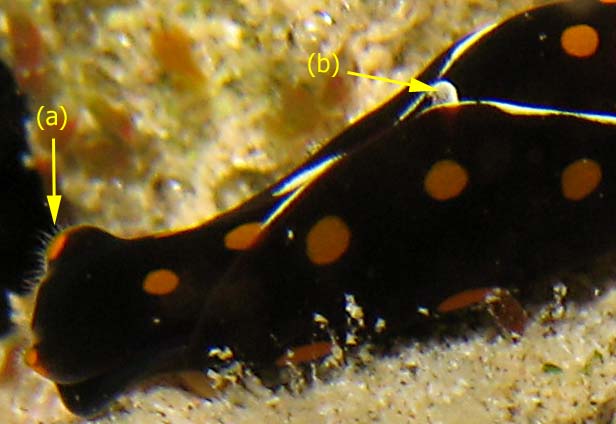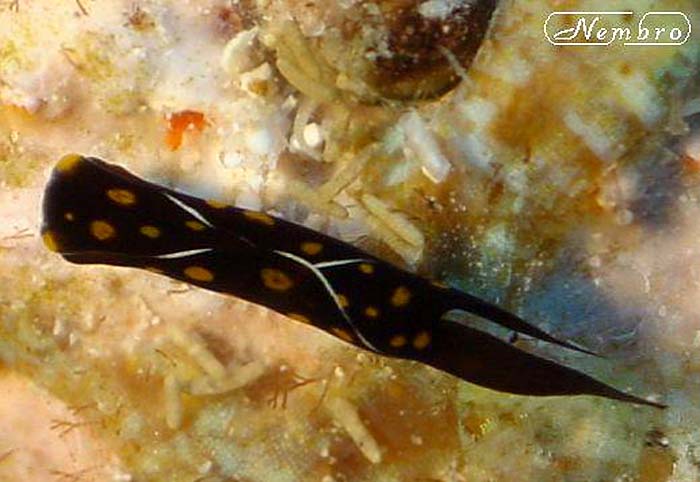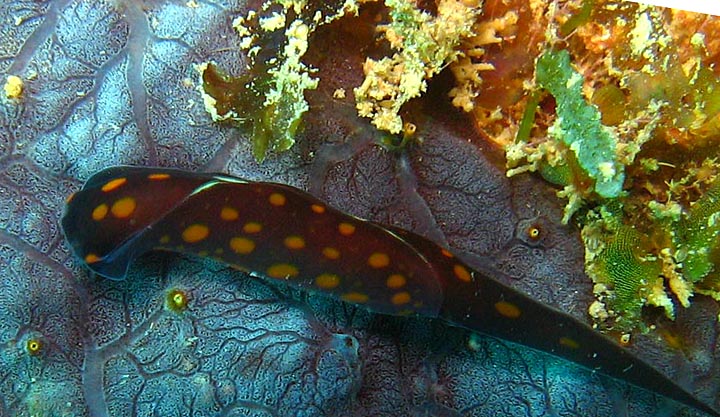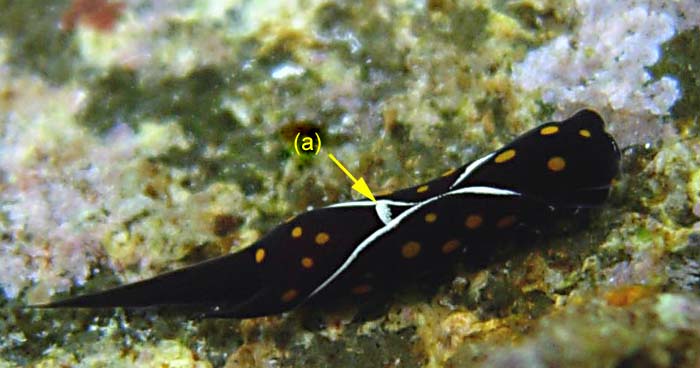This species has been observed on Reunion, Mayotte, Mauritius, Madagascar and Seychelles Islands
The body was dark brown, appearing almost black, with bright yellow orange spots and dots; these orange markings extended on the ventral surface
. |

|
|
| Showing species characteristics... | Photo Sophie Darnis |
|
See more about : Sightening and mating periods
See more about : Chelidonura punctata variability in Southwest Indian ocean
See more about : Spawn and courtship behavior ?
Remarks :
Identification confirmed by Bill Rudman
Synonymous : (according Worms)
- Chelidonura hirundinina var. punctata Eliot, 1903
Bibliographic data :
Species with and a transverse white marking at the posterior margin of the cephalique shield.
The main colour difference with Mariaglaja sandrana is that the yellow spots in that species, if present, are much smaller and are not found on the ventral surface while in C. punctata the spots are relatively large and do occur on the sole of the foot. M. sandrana is also usually smaller.
They are often observed, crawling over corals. They search for their prey, small flatworms which often occur on coral colonies in large numbers.
"Trailing" in aglajids is quite a common phenomenon and often ends in mating. In aglajids the penis is on the right side of the head and the female genital opening is at the posterior end of the body. These animals therefore often mate 'head to tail' with the anterior one acting as female and the posterior one as male.
When crawling, aglajids secrete a coat of mucus which can cover their whole body, so they are really crawling along in a tube of mucus. When still this coat can increase to form a temporary nest.
There are sensory cilia on the anterior edge of the head
This "yellow gland" was found in all the Aglajidae. It is a large gland sac sitting in the posterior end of the body cavity and opening just to the left of the anus into the mantle cavity. It releases a bright yellow secretion on some occasions when the animal is disturbed.
To test the nature of the yellow secretion Bill Rudman collected it from the New Zealand aglajid Melanochlamys cylindrica and placed it in a watch-glass of fresh sea water. Polychaete worms, up to 50mm long, the normal food of this species, were paralysed in a few seconds if placed in this solution but would recover if removed within 30 seconds. They would die within 2-3 minutes if left in the yellow gland secretion.
The secretion is only produced sometimes, and since the mantle cavity is at the rear of the body it would not be much use in primary defence or for stunning potential prey. Bill Rudman suspect (Rudman, 1972), it is an excretory product with no direct function
Material examined by Nathalie Yonow ( see reference/publications).
One specimen collected from Flic en Flac (Mauritius), 15 October 1985, size : 20 mm
References :
Bill Rudman Seaslug site : Sea Slug Forum : Chelidonura punctata
Nudipixel Chelidonura punctata
Publications :
Rudman,W.B., 1973. On some species of Chelidonura (Opisthobranchia: Aglajidae) from Zanzibar and Fiji. Zoological Journal of the Linnean Society, 52 : 201-215.
Rudman, W.B. (1972) On Melanochlamys Cheeseman, 1881, a genus of the Aglajidae (Opisthobranchia: Gastropoda). Pacific Science, 26(1) : 50-62
Rudman, W.B. (1974) A comparison of Chelidonura, Navanax and Aglaja with other genera of the Aglajidae (Opisthobranchia, Gastropoda). Zoological Journal of the Linnean Society 54(3) : 185-212.
Yonow, N, Anderson R.G, and Buttress S.G, (2002). Opistobranch molluscs from the Chagos Archipelago, Central Indian Ocean. Journal of Natural History. 36, 831-882
Yonow N. (2012) Opisthobranchs from the western Indian Ocean, with descriptions of two new species and ten new records (Mollusca, Gastropoda). ZooKeys 197: 1–129. [22 May 2012]
Zamora-Silva A. & Malaquias M.A.E. (2017). Molecular phylogeny of the Aglajidae head-shield sea slugs (Heterobranchia: Cephalaspidea): new evolutionary lineages revealed and proposal of a new classification. Zoological Journal of the Linnean Society
Other photos of Chelidonura punctata :
Philibert Bidgrain
Réunion, La saline lagoon, less 1 m, 9 April 2010, size : 15-20 mm About 10 specimens in a little area on the reef crest with about 50 C. hirundinina There are sensory cilia (a) on the anterior edge of the head A specimen with and a transverse white marking (b) at the posterior margin of the cephalique shield.... |
 |
 |
Maurice Jay
Réunion, "Mare de Baramine", Saint Paul A specimen with relative small yellow spot and a transverse white marking at the posterior margin of the cephalique shield.... The yellowish brown stain in the water at the posterior end of its body, corresponded to a secretion from its yellow gland, which is a gland found only in the Aglajidae. |
Internal shell of the upper spécimen. Size : 7 mm Flimsy and very thin internal shell with curved apex and large axial undulations. |
 |
Maurice Jay
Réunion, "Mare de Baramine", Saint Paul, in November-December, size : 25 mm Like all members of this genus, the left tail process was distinctly longer than the right, with orange spot in the larger specimens and witnout spots in the smaller |  |
 |
Marina Poddubetskaia "Passe Bateau", N'gouja, Mayotte, 13 m, 2 November 2003, size : 5-7 mm Fine white edges were present on the parapodia, becoming less distinct and grey anteriorly. |
Sylvain Le Bris Mayotte, 4 December 2008 On a lovely blue sponge... |
 |
 |
Christophe Cadet Etang salé lagoon, less 1 m, 29 October 2009, size : 7 mm A specimen with and a transverse white marking (a) at the posterior margin of the cephalique shield....
|
In Nudibranches of Seychelles by Christophe Mason-Parker Observed at Therese Island, size : 20 mm
|
Available online on Archipelago Island
|
More photos from Indian Ocean
See more about : Chelidonura punctata variability in Southwest Indian ocean
See more about : Spawn and courtship behavior ?
Mauritius, Chelidonura punctata, at Pereybere, by Marina Poddubetskaia
Reunion, Chelidonura punctata, at Saint Leu, by Philibert Bidgrain
Reunion, a small population of Chelidonura punctata, at La Saline, by Philibert Bidgrain
Madagascar, Chelidonura punctata, at Nosy Bé, by Alain-Benoît Rassat
Reunion, massive mating of Chelidonura punctata, at Cap la Houssaye, by Seb Vasquez